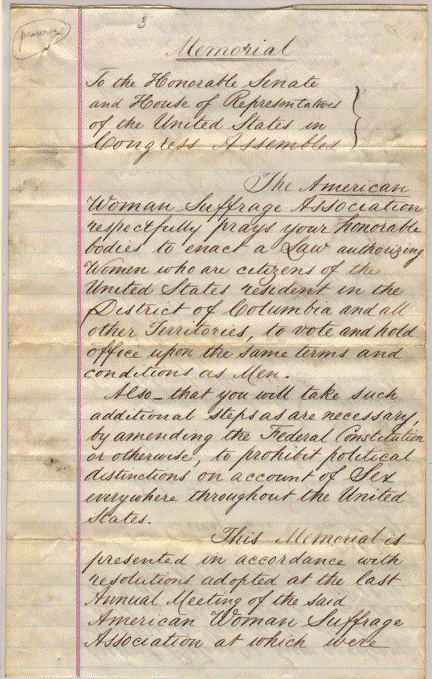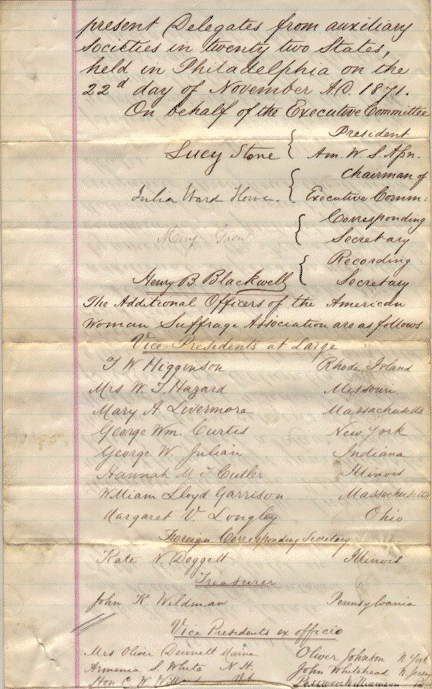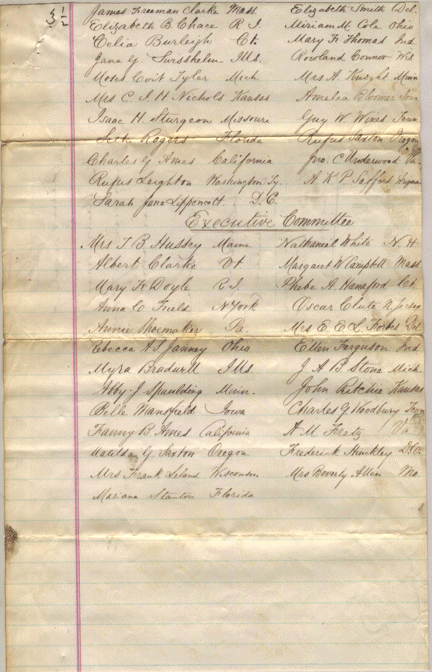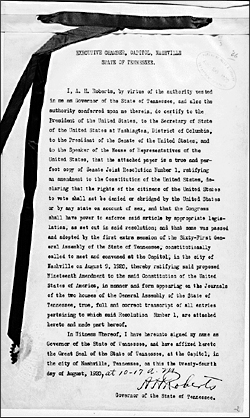The ideological and strategic differences that grew among suffrage leaders during and immediately after the Civil War formally split the women's movement into two rival associations. Stanton and Anthony, after accusing abolitionist and Republican supporters of emphasizing black civil rights at the expense of women's rights, formed the National Woman Suffrage Association (NWSA) in May of 1869. The American Woman Suffrage Association (AWSA), founded 6 months later by Lucy Stone, Julia Ward Howe, and Thomas Wentworth Higginson, protested the confrontational tactics of the NWSA and tied itself closely to the Republican Party while concentrating solely on securing the vote for women state by state. In 1890 the two suffrage organizations merged into the National American Woman Suffrage Association (NAWSA). Stanton became its president, Anthony became its vice president, and Stone became chairman of the executive committee.
In 1919, one year before women gained the right to vote with the adoption of the 19th amendment, the NAWSA reorganized into the League of Women Voters.



Memorial to Congress from The American Woman Suffrage Association
Record Group 233 Records of the U.S. House of Representatives National Archives and Records Administration
Early in 1919, the House of Representatives passed the 19th amendment by a vote of 304 to 90, and the Senate approved it 56 to 25. Illinois, Wisconsin, and Michigan were the first states to ratify it. On August 18, 1920, it appeared that Tennessee had ratified the amendment--the result of a change of vote by 24 year-old legislator Harry Burn at the insistence of his elderly mother--but those against the amendment managed to delay official ratification. Anti-suffrage legislators fled the state to avoid a quorum and their associates held massive anti-suffrage rallies and attempted to convince pro-suffrage legislators to oppose ratification. However, Tennessee reaffirmed its vote and delivered the crucial 36th ratification necessary for final adoption.
Some states were slow with their endorsement even after the amendment became a part of the supreme law of the land. Maryland, for example, did not ratify the amendment until 1941, and did not transmit the ratification document to the State Department until 1958.


https://www.archives.gov/files/historical-docs/doc-content/images/19th-amendment.pdf
There it is, the reason to leave our homes today!
Passed by Congress June 4, 1919, and ratified on August 18, 1920, the 19th amendment granted women the right to vote.
print-friendly version
The 19th amendment guarantees all American women the right to vote. Achieving this milestone required a lengthy and difficult struggle; victory took decades of agitation and protest. Beginning in the mid-19th century, several generations of woman suffrage supporters lectured, wrote, marched, lobbied, and practiced civil disobedience to achieve what many Americans considered a radical change of the Constitution. Few early supporters lived to see final victory in 1920.
Beginning in the 1800s, women organized, petitioned, and picketed to win the right to vote, but it took them decades to accomplish their purpose. Between 1878, when the amendment was first introduced in Congress, and August 18, 1920, when it was ratified, champions of voting rights for women worked tirelessly, but strategies for achieving their goal varied. Some pursued a strategy of passing suffrage acts in each state—nine western states adopted woman suffrage legislation by 1912. Others challenged male-only voting laws in the courts. Militant suffragists used tactics such as parades, silent vigils, and hunger strikes. Often supporters met fierce resistance. Opponents heckled, jailed, and sometimes physically abused them.
By 1916, almost all of the major suffrage organizations were united behind the goal of a constitutional amendment. When New York adopted woman suffrage in 1917 and President Wilson changed his position to support an amendment in 1918, the political balance began to shift.
On May 21, 1919, the House of Representatives passed the amendment, and 2 weeks later, the Senate followed. When Tennessee became the 36th state to ratify the amendment on August 18, 1920, the amendment passed its final hurdle of obtaining the agreement of three-fourths of the states. Secretary of State Bainbridge Colby certified the ratification on August 26, 1920, changing the face of the American electorate forever.
https://www.archives.gov/education/lessons/woman-suffrage

No comments:
Post a Comment